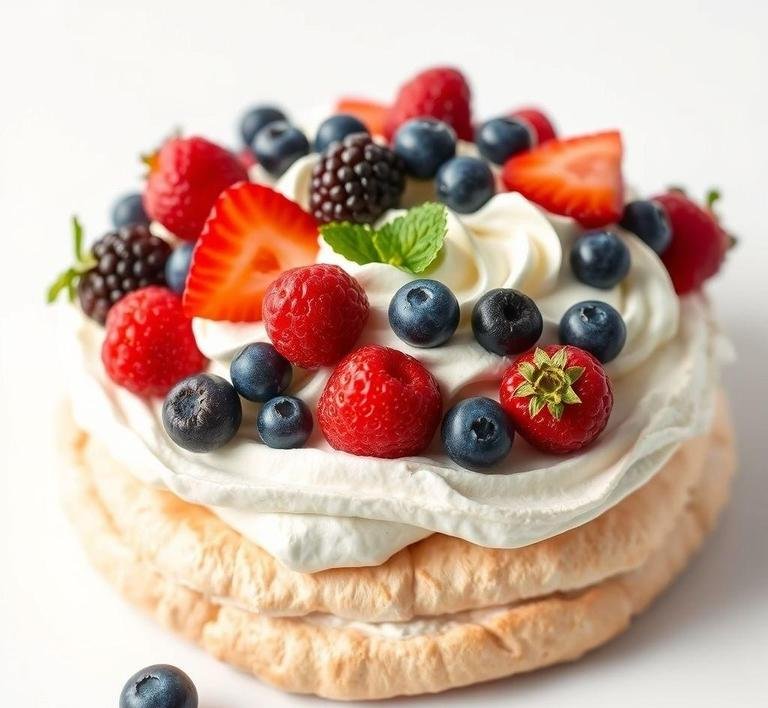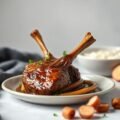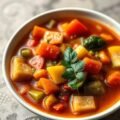Jamie Oliver’s Pavlova is a showstopper dessert. Imagine a crispy-on-the-outside, marshmallowy-on-the-inside meringue, topped with billowy whipped cream and a riot of fresh, juicy fruits. That’s Pavlova. Named after a Russian ballerina, it’s as elegant as it is indulgent.
Jamie adds his signature twist by layering bold, fresh flavors. sometimes going tropical with passion fruit or keeping it classic with berries. He often balances the sweetness with tart fruit and sometimes adds herbs like mint or lemon zest for extra zing. It’s rustic, not too fussy and all about texture and contrast. Crisp meringue, silky cream, juicy fruit. Boom.
Jamie Oliver Pavlova Recipe
Ingredients Needed
Jamie’s recipes are flexible but here’s a pretty standard take inspired by his style:
For The Meringue
- 6 large free-range egg whites
- 300g caster sugar
- 1 pinch of sea salt
- 1 teaspoon white wine vinegar
- 1 teaspoon cornflour
- A few drops of vanilla extract (optional but lovely)
For The Topping
- 300ml double cream
- 1 tablespoon icing sugar (for sweetness)
- 1 teaspoon vanilla extract
- Fresh fruit: strawberries, raspberries, blueberries, passion fruit, kiwi or mango. whatever’s ripe and in season
- Zest of 1 lime or lemon (optional but sharp and zesty)
- Fresh mint (just a few leaves for a cool hit)
Jamie often encourages improvisation. so feel free to go wild with the fruit.
Equipment Needed
You don’t need a fancy kitchen setup. Here’s what helps:
- Mixing bowls (glass or metal for the egg whites-plastic can mess with the fluff)
- Electric whisk or stand mixer (unless you fancy a serious arm workout)
- Baking tray
- Baking paper or a silicone mat
- Spatula
- Spoon (for shaping the meringue)
- Cooling rack
- Knife and chopping board for prepping fruit
- Fine grater (for zest)
And if you want to be exact with the sugar, a kitchen scale helps. But this isn’t a recipe that punishes you for not being ultra-precise.
How To Make Jamie Oliver’s Pavlova
Here’s how it goes down, step by step:
1. Preheat And Prep
Set your oven to 150°C (130°C fan) or 300°F. Line a baking tray with parchment paper and draw a circle if you want a neat base. Flip it over so the pen doesn’t touch the food.
2. Whip It Real Good
In a clean, dry bowl, whisk your egg whites with a pinch of salt until soft peaks form. Slowly add the caster sugar-tablespoon by tablespoon. Keep whisking. You want glossy, stiff peaks. You should be able to turn the bowl upside down without disaster.
Now fold in the vinegar, cornflour and vanilla. These give you that dreamy marshmallow middle and crisp shell.
3. Shape The Base
Spoon the meringue onto your baking sheet in a big cloud. Pile it high and swirl it. You want drama-peaks, waves, texture. Make a slight dip in the center for the cream later.
4. Bake Low And Slow
Pop it in the oven, then immediately lower the temp to 120°C (250°F). Bake for 1 hour and 15 minutes. Turn off the oven and leave it to cool inside with the door ajar. This prevents cracks (though a few are part of the charm).
5. Whip The Cream
Once the meringue’s cool, whisk the cream with the icing sugar and vanilla. You want soft peaks. not too stiff. This cream is your silky pillow for the fruit.
6. Decorate Like A Pro
Dollop the cream onto the meringue, then top with your fresh fruit. Slice, scoop, scatter-no need for perfection. Add zest or mint to finish. The whole thing should look casual but irresistible.
What I Learnt

Making Pavlova is kind of magical. You start with humble egg whites and sugar and suddenly you’re sculpting clouds.
I learnt patience is key. don’t rush the meringue. Whip it properly and bake it slowly. Also, the fruit really matters. It’s not just garnish. it balances the sweetness and adds that fresh bite.
I also realized this is a dessert that forgives. If your meringue cracks? Still tastes amazing. If the cream swirls unevenly? Still gorgeous. It’s not about perfection. it’s about flavor, texture and joy.
Recipe Tweaks For Jamie Oliver’s Pavlova
Jamie Oliver’s pavlova is already a thing of beauty-crispy on the outside, marshmallowy on the inside, piled high with cream and fruit. But let’s be honest, even the greats leave room for a little personal flair.
1. Swap the Sugar (Just a Bit):
Jamie uses caster sugar for that perfect crunch. Want a more caramelized depth? Try using half golden caster sugar. It’ll give the meringue a subtle toffee flavor that pairs beautifully with tropical fruits.
2. Flavor the Meringue:
Don’t stop at plain vanilla. Add a few drops of orange blossom water or a hint of rose extract. Go easy-just a whisper. It elevates the whole dessert without overpowering it.
3. Upgrade the Cream:
Heavy cream is classic. But why not mix in a spoonful of mascarpone or Greek yogurt? It gives the topping more body and a gentle tang that balances the sweetness of the meringue.
4. Play with the Fruit:
Jamie’s recipe often leans on berries or passionfruit. Both are lovely but don’t be afraid to go seasonal. In autumn? Try poached pears or roasted figs. Summer? Sliced mango, grilled peaches or fresh cherries. You get the idea-fruit should feel exciting, not obligatory.
5. Add a Crunch Factor:
Pavlova’s texture is all about contrast. Toss some toasted almonds, crushed pistachios or cocoa nibs over the top. It gives the dessert that little ’oomph’ and makes each bite more interesting.
6. Sauce It Up:
Jamie sometimes adds a fruit compote which is fab. But if you want to make people lose their minds, drizzle over some dark chocolate ganache or a citrusy coulis. Just a thin ribbon over the cream and fruit-gorgeous.
Storage Tips For Leftovers
First, let’s be real-pavlova leftovers are a rare species. But on the off chance you didn’t inhale the whole thing in one sitting, here’s how to save the rest without losing that iconic texture.
1. Keep It Separate If You Can:
If you’ve made individual portions or have a plain meringue base left, store it on its own in an airtight container. Room temp is fine. just keep it dry and away from heat. It’ll last 2-3 days before it starts to go soft.
2. Assembled Pavlova? It’s Tricky.
Once it’s piled with cream and fruit, it becomes a delicate beast. Store the assembled pavlova in the fridge, uncovered or loosely tented with plastic wrap. Don’t seal it tightly. it’ll trap moisture and turn everything soggy. Aim to eat within 24 hours.
3. Don’t Freeze It (Mostly):
Meringue doesn’t love the freezer. it cracks, it weeps, it turns sad. However, you can freeze the unassembled meringue base if it’s totally dry. Wrap it carefully in parchment, then foil and stash in a freezer-safe container. Thaw it gently at room temp, unwrapped.
What To Eat With Jamie Oliver’s Pavlova?
Okay, so pavlova is a showstopper all on its own. But if you’re making a whole meal or want to pair it with something complementary, here are some delicious ideas.
1. Light Main Courses:
You want something that won’t overshadow the dessert. Think grilled fish, lemony chicken or a simple summer pasta. Herbs and citrus are your friends-keep it bright and clean.
2. Fresh Salads:
A salad sounds basic but hear me out. A crunchy, slightly bitter salad-like rocket with shaved fennel and orange segments. makes a killer contrast to the sweetness of the pav. Bonus if you toss in nuts or goat cheese.
3. Sparkling Drinks:
Champagne or Prosecco is perfect. Or go non-alcoholic with a chilled elderflower spritz or sparkling water with lime and mint. Anything fizzy cuts through the sugar and refreshes your palate.
4. Coffee or Tea Afterward:
Once the pavlova’s gone, you’ll want something warm. Espresso is a classic but a floral tea (like jasmine or mint) also works wonders, especially if you’ve used citrus or tropical fruits in the pavlova.
FAQs
What Makes Jamie Oliver’s Pavlova Recipe Unique?
His recipe focuses on a crisp outer shell and soft, marshmallow-like center, with a generous topping of whipped cream and fresh fruit.
Can I Make Jamie Oliver’s Pavlova Ahead Of Time?
Yes, the pavlova can be made a day before serving. Just store it in an airtight container to keep it crisp.
What Fruit Works Best On Jamie Oliver’s Pavlova?
Berries like strawberries, raspberries, and blueberries are popular, but you can also use tropical fruits like passionfruit or kiwi.


